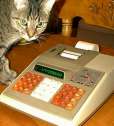Texas Instruments TI-55-II
| Datasheet legend
Ab/c:
Fractions calculation
AC: Alternating current BaseN: Number base calculations Card: Magnetic card storage Cmem: Continuous memory Cond: Conditional execution Const: Scientific constants Cplx: Complex number arithmetic DC: Direct current Eqlib: Equation library Exp: Exponential/log functions Fin: Financial functions Grph: Graphing capability Hyp: Hyperbolic functions Ind: Indirect addressing Intg: Numerical integration Jump: Unconditional jump (GOTO) Lbl: Program labels LCD: Liquid Crystal Display LED: Light-Emitting Diode Li-ion: Li-ion rechargeable battery Lreg: Linear regression (2-var. stats) mA: Milliamperes of current Mtrx: Matrix support NiCd: Nickel-Cadmium recharg. batt. NiMH: Nickel-metal-hydrite rech. batt. Prnt: Printer RTC: Real-time clock Sdev: Standard deviation (1-var. stats) Solv: Equation solver Subr: Subroutine call capability Symb: Symbolic computing Tape: Magnetic tape storage Trig: Trigonometric functions Units: Unit conversions VAC: Volts AC VDC: Volts DC |
| ||||||||||||||||||||||||||||||||||||||||||||||||||||||||
Texas Instruments TI-55-II
 Yet another of Texas Instrument's "almost programmable" calculators, the TI-55-II is obviously a successor of the TI-55. The LED display was replaced with an LCD panel and buttons were added that made programming somewhat easier.
Yet another of Texas Instrument's "almost programmable" calculators, the TI-55-II is obviously a successor of the TI-55. The LED display was replaced with an LCD panel and buttons were added that made programming somewhat easier.
Interestingly, the TI-55-II had less memory than the TI-55, even though it was more flexibly partitioned. Whereas the TI-55 had a total memory equivalent to 10 storage registers (8 addressable registers, 2 of which overlapped 16 out of the calculator's 32 program steps), the TI-55-II has the equivalent of 8 registers, although it is possible to convert as many as 7 of these into 56 steps of program memory.
Another difference is the behavior of the RST function in program mode. On the TI-55 it resets the program counter to 00, but program execution doesn't stop, which allows for the creation of simple looping constructs. On the TI-55-II execution does stop, so similar loops are not possible (or at least, I haven't found a way to create them in the absence of a manual.)
This severely limits the utility of this calculator, despite the presence of advanced functions such as a numerical integral, which evaluates the integral of the function represented by the keycode sequence in program memory. Without loops, one cannot write a factorial program, for instance; the limited size of the program memory makes it impossible to enter complex expressions such as those used for the Gamma function. Instead, here is a version of Stirling's formula that provides a reasonable approximation of the factorial for arguments greater than 0.5. (For very small arguments, the function quickly diverges, whereas for 0 or negative arguments, it results in an error.) The program is small enough to leave room for 4 storage registers, of which one is used by the program itself:
00 61 STO
01 00 0
02 65 ×
03 02 2
04 65 ×
05 91 π
06 95 =
07 13 √
08 65 ×
09 71 RCL
10 00 0
11 45 yx
12 71 RCL
13 00 0
14 55 ÷
15 71 RCL
16 00 0
17 41 INV
18 44 lnx
19 65 ×
20 53 (
21 71 RCL
22 00 0
23 17 1/x
24 55 ÷
25 01 1
26 02 2
27 85 +
28 01 1
29 95 =
30 22 RST

